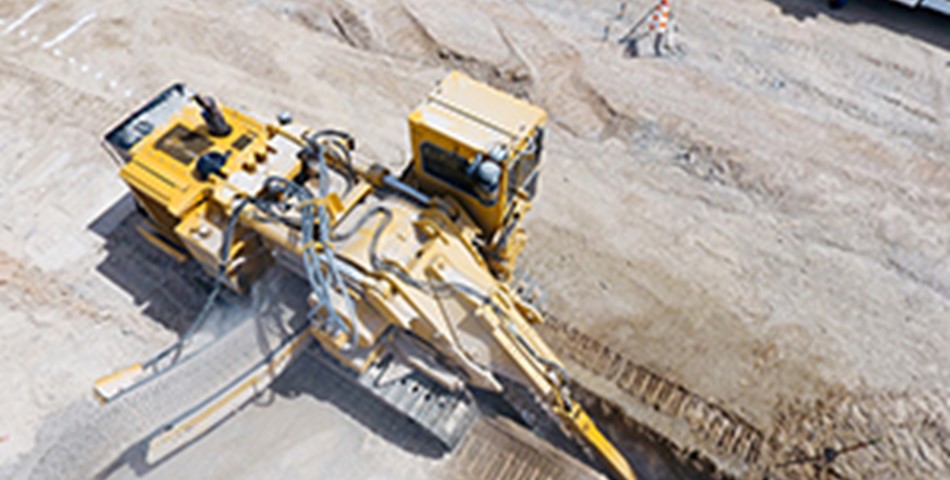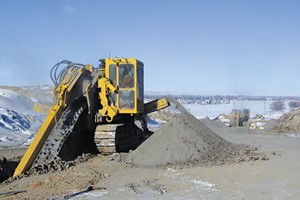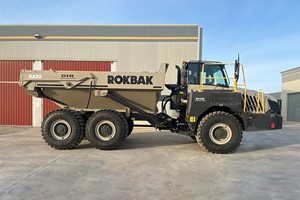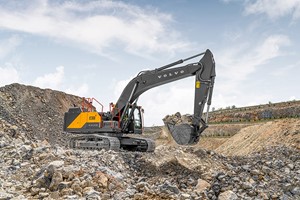A trencher is a more efficient and productive solution on some projects and in certain ground conditions. We’re not talking about a pedestrian trencher, or a utility trencher used more for installing fiber, cable, irrigation, and electrical lines. Large diameter takes a large trencher on tracks with carbide teeth designed for cutting rock. On many jobs, just one of these types of trenchers can outperform as many as four excavators.
The role of a trencher
According to Vermeer Applications Specialist Gregg Van Roekel, many contractors think they understand how trenchers work, and their productivity in open-cut applications, but have concerns about investing in this dedicated machine. “When I meet with contractors, I explain that a trencher can complement existing machines, and they can get more out of their other equipment with the addition of a trencher. It’s easier to see the value in taking it to a jobsite. We’re not here to replace a fleet of other equipment. We’re here to help make it better.”
Sizing a trencher
Determining the right-sized trencher is dependent on the type of ground conditions the machine be working in. Smaller, lower-horsepower machines are efficient in soft soils, but as the relative hardness of the ground increases, so do the demands on the machine. Trenching harder rock requires more weight and horsepower, and the right trencher will handle the application better.
“If you’re trenching with nice, black dirt in the Midwest, you don’t need as much power. If you’re working in south Texas where it’s solid rock, the conditions will be harder on the machine,” said Van Roekel. “You need to get the right-sized machine so that it can perform in the application and optimize production.”
But, with power comes size. Higher-horsepower trenchers are larger in size. Often, they’re so much bigger, the process of moving them from job to job can inhibit operators from adding new work because of the time and cost of moving the machines. That makes it important to balance the size of the trencher’s performance with its physical size.
“Some operators want a big machine, but they want to be able to haul it around conveniently,” Van Roekel said. “You can’t really load a 260 000 lb (117 934 kg) machine at a jobsite in one truckload.”
Trenching is the most cost-efficient solution for most applications.
The main advantages of this technology are:
- Productivity advantages
One large trencher (90-150 ton class) can substitute up to 15 excavators (20-25 ton class). Also, trenchers cut the minimum required ditch width which equates to less cubic meters being dug for each linear meter of production, reducing the excavation area by at least 30% (Trencher vs Excavator).
- Logistic advantages
More production with fewer machines and operators results in a lower cost of logistics and makes it easier to manage the worksite.
- Cost advantages
The cost of purchasing a trencher versus the cost of a fleet of excavators is similar, however, the digging cost per linear meter when using rock breakers is about 55-60 % higher than that of a trencher. Trenchers also have a lower operating, labor, and maintenance costs when compared to excavators. Trenchers excavates the rock into smaller pieces which means, there is no longer a need for large loaders and dump trucks, a smaller quantity of back-fill material is needed, and it saves in transportation costs.
- Environmental advantages
Fewer machines mean less CO2 emissions, and by breaking up the rock into smaller pieces as the trencher excavates it, it becomes a usable backfill material which leads to less wasted material. In retrospect, the cost of bedding & backfilling with an excavator will be 35-65% higher than that of a trencher. Trenchers also produce less dust, vibration, and noise than using explosives so they can be potentially used in areas near bridges, roads, railways, and populated areas in general.
- Bedding and Backfilling advantages
A vertical wall trench requires less backfill material than a “V” wall excavated trench; making it easier and less expensive to backfill. It is also easier to get good compaction of backfill material which reduces the risk of erosion and surface collapse.
- Safer technology
The use of explosives is subject to increasing regulations and restrictions, but trenchers can be used everywhere. Finally: less crew on the jobsite means less risks of injury or incident.
Trenchers Market Size 2022
Trenchers Market is estimated to maximum a healthy market growth at a healthy CAGR of 1.5%. According to our latest research, the global Trenchers market size is estimated to be worth USD 677.9 million in 2022 and is forecast to a readjusted size of USD 741.2 million.
Due to the COVID-19 pandemic, the global Trenchers market size is estimated to be worth USD 677.9 million in 2022 and is forecast to a readjusted size of USD 741.2 million by 2028 with a CAGR of 1.5% during the review period.
Tesmec was the global biggest manufacturer in Trenchers industry, with the revenue market Share of 23%, followed by Charles Machine Works, Vermeer, Inter-Drain, Cleveland, Wolfe Heavy Equipment, Barreto, Mastenbroek, EZ-Trench, Guntert and Zimmerman, Port Industries, UNAC, Gaotang Xinhang Machinery, Shandong Gaotang Trencher.
Asia-Pacific is the largest Trenchers market with about 38% market share. North America is follower, accounting for about 30% market share.












